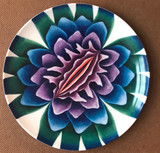
An Educated Collector is Our Best Client
In business for nearly two decades, we are a well established, popular contemporary art boutique specializing in expertly chosen, blue chip prints, multiples, uniques, books, ephemera and merchandise at different price points, with a focus on the secondary market. Please click on the "Contact Us" button at the bottom of this page for questions about any work, pricing and/or to arrange to visit our showroom/gallery - located in between Manhattan's Flatiron and Chelsea Flower Districts.
ALPHA 137 GALLERY
ALPHA 137 GALLERY
Judy Chicago, Hildegard of Bingen, from "The Dinner Party", Cloisonne Brooch (1st Edition, signed), 1987
SOLD
Description
Judy Chicago
Hildegard of Bingen Cloisonne Brooch (1st Edition, signed), 1987
Cloisonne brooch/pin with clasp on the back
Artist's authorized signature, date and copyright on the reverse (very rare)
Limited Edition of 2000
Despite Judy Chicago's incredible productivity and popularity, design objects like this that she created in the 1980s are very scarce. The present 1987 object is incredibly hard to find; most of the ones that appear on the market are dated one year later - 1988 - and bear the artist's printed name. This is the first edition, dated 1987, with Judy Chicago's original incised signature and copyright.
This cloisonné pin relates to the original “Hildegard of Bingen” place setting from The Dinner Party. (For inspiration only, we are showing a photograph of Hildegard Dinner Party setting in the permanent collection of the Brooklyn Museum). Hildegard of Bingen (or Saint Bingen) was a German Christian mystic and visionary who lived between 1098-1179. Her other-worldly visions inspired her much celebrated and studied writings, music compositions, and philosophy. In addition to her religious pursuits, Hildegard wrote volumes on medical diagnosis and treatment along with scientific findings and documentation, she is credited as the founder of scientific natural science in Germany. Judy Chicago's The Dinner Party is a groundbreaking work of feminist art and is a transformative accomplishment in American art of the 20th century. It debuted to much sensationalism in 1979, The Dinner Party ultimately toured several continents reaching an audience of millions. After many years in storage, in 2007 it re-opened in its permanent home at the (likely soon to be re-named!) Elizabeth A. Sackler Center for Feminist Art at the Brooklyn Museum, New York. Judy Chicago conceptualized this large-scale installation to serve as a symbolic history of women in Western civilization. The Dinner Party is comprised of a huge ceremonial banquet table with 39 place-settings. Each place-setting commemorates a historical or mythical female figure including artists, goddesses, activists, and martyrs. Each of these unique place-settings includes a hand-painted plate depicting a brightly-colored and elaborately styled pattern (often in forms that recall female sexual organs). Like many of the elements of The Dinner Party, this cloisonné pin similarly embellishes and celebrates a marginal (but radical) figure from the history of civilization and feminist history.












